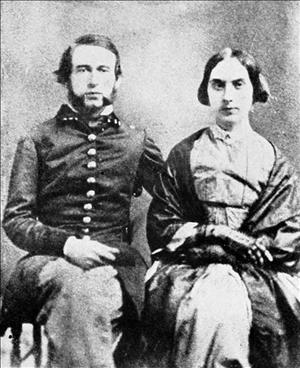On December 4, 1855, Native Americans under Klickitat Chief Kanasket attack a U.S. Army encampment between the Green and White rivers and kill Lieutenant William Slaughter (1827-1855) and three other soldiers. The soldiers are from the 4th U.S. Infantry and the 4th U.S. Artillery Regiments from Fort Steilacoom. The Indians are from the Puyallup, Nisqually, and Klickitat tribes.
Three-Hour Battle
When Indians killed settlers along the White River in October 1855, Acting Territorial Governor Charles H. Mason (1830-1859) requested help from soldiers at Forts Steilacoom and Vancouver. On November 3, 1855, Captain Maurice Maloney deployed 50 soldiers under Lieutenant Slaughter and about the same number of volunteers under Captain Gilmore Hays up the White River. The force encountered some Indians on opposite side of the river, but the water was too deep to cross. The two groups exchanged gunfire at long range. Lieutenant Slaughter estimated he killed 30 warriors while losing just one man of his own. Maloney continued patrolling between the White and Green Rivers, but the tribesmen stayed out of his way.
On December 4, 1855, the soldiers stopped and built fires at an abandoned homestead to dry out their wet clothing. Lieutenant Slaughter and other officers were conferring in a hut when, just past 7 p.m., Native Americans fired a volley into the camp and a rifle ball passed between the logs of the hut and into the officer's heart. This set off a three-hour battle in which three other soldiers died. Captain Erasmus Keyes (1810-1895) took command and pulled the force back to Fort Steilacoom.
Lieutenant Slaughter and his wife had been a popular couple at Fort Steilacoom (she was one of few white women there) and his loss rattled Puget Sound settlers. Captain Keyes reported that the region was in a "condition of wild alarm." James Tilton observed with some disdain that the streets of Olympia were "filled with a timid ignorant fault-finding mob of Pikes, who terrify each other by horrid exaggerations about Indians, and whose [land] claims are going to hell" (Richards, 257).
Acting Governor Mason dispatched Captain Isaac L. Sterrett to Seattle to round up all the Snoqualmie Indians. Arthur Denny (1822-1899) convinced Sterrett that the Snoqualmies were not hostile. Lieutenant Slaughter was remembered in the name of a city and a county in Washington Territory, but citizens renamed the city Auburn and the county Kitsap.

